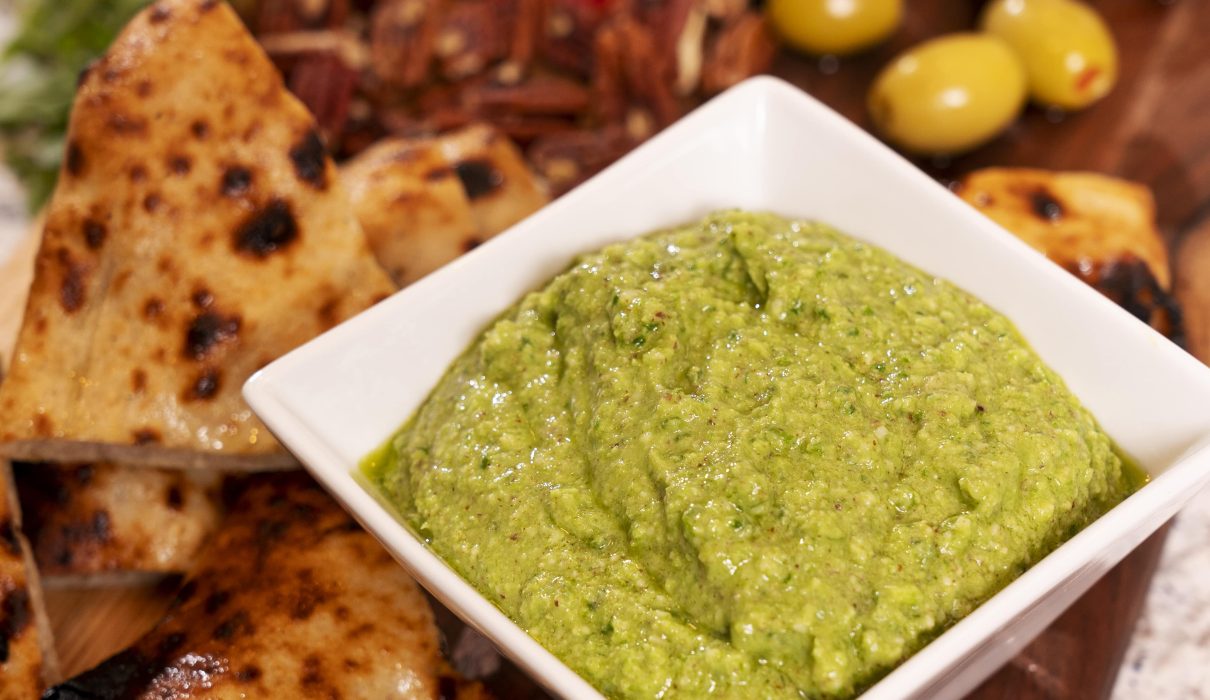Photos by L.G. Patterson
I love basil and pesto, but I don’t always enjoy growing basil. I look forward to spring to have fresh basil leaves to use for caprese salad, topping on pizza or tossing into pasta. But I don’t look forward to the time of year when it starts to bolt to seed and you are left with more spindly flowers and very few leaves.

This made me think about what else could be substituted in pesto. Pine nuts are commonly used in pesto but are one of the most expensive nuts (and not local to Missouri). I have had good luck with pecans in pesto, and they are available statewide.
This brought me to my next pesto substitution. Each year in late May or early June, a neighbor brings me garlic scapes. Hardneck garlic varieties have a scape that grows from the center of the stalk as a curl at first, then begins to straighten just before the end flowers to produce seeds. (Consider checking out the botanical definition of a scape sometime; they define it much better than I do.) Most hardneck garlic growers cut off the scape just before the curl straightens. This is when the scape is most tender, as it becomes tough and woody to support the flower.
By harvesting the scape, the energy that the garlic would put into the flower can now be focused on the bulb. This can result in garlic bulbs that are 30 percent larger than if the scape was left on.
I would stir fry the scapes, use them with pasta or in omelets, or even pickle them. Then I came across someone substituting the scapes for basil in pesto. I decided to give it a try; it was a hit. The pungent garlic flavor comes through and the sturdy scapes process much easier than basil.
I was hooked. So much so that I started growing hardneck garlic the following year, a little for the garlic, but mostly for the scapes.
Unfortunately, by this time of year (unless you have saved some in your fridge as they save well for months), all of the garlic scapes are gone, but you can still make pesto with a variety of different ingredients, in case you might just be ready to rip out the rest of that pesky basil. You mostly want to judge how to make it based on taste, but what follows is a rough ratio that I use.
BY VOLUME:
- 4 parts green things (basil, scapes, arugula)
- 1 part nuts (pecans, pine nuts, almonds)
- 1 part Parmesan (another hard sharp cheese could be substituted)
- 1 to 2 parts olive oil
- Lemon juice to taste – 1⁄2 to 3⁄4 part
- Salt to taste
GREENS
Basil (leaves and softer parts of the stem) is traditional, but garlic scapes, green garlic, wild garlic, arugula, parsley, spinach, kale, asparagus, cilantro, mint and probably any other green you want to try can be used. Some items may lend to a milder pesto with a vibrant color if blanched. I prefer a strong taste, but blanching will help set and preserve the chlorophyll to give it a more vibrant green color. Depending on what type of green you are using (less time for leaves, more time for stalks), blanch by plunging the items in boiling water for 10 to 60 seconds, then immediately into ice water. You will notice the color becomes much more vibrant. This will make the flavor milder but have a much brighter color for longer.
NUTS
Pine nuts are not the only way to add texture to a pesto. Most other nuts (including pecans, walnuts, pistachios, cashews, almonds, sunflower seeds) will substitute well to make pesto. The nuts help give body and flavor, and lightly toasting, then cooling, will help develop even more flavor. If you have a nut allergy, don’t fret. The texture and flavor also can be mimicked by substituting toasted breadcrumbs. Lightly toast or fry the breadcrumbs in olive oil until they become golden brown. Cool and then substitute as normal in the recipe.
CHEESE
Parmigiano-Reggiano is king for making pesto, but you can use a variety of different, less expensive cheeses. Pecorino Romano, aged cheddar, aged feta, Asiago, ricotta salata or any other aged hard cheese. If dairy is the issue, you can just add in some more nuts; if you want to add back in some of that cheesy flavor, try adding a bit of nutritional yeast.
ACID
Lemon juice is most common as it has a great flavor that does not overpower the other ingredients. But if you are wanting to highlight the flavor of other acids, consider trying lime juice, grapefruit juice, white wine vinegar, apple cider vinegar or verjus (the pressed juice of unripened grapes). Along the same lines, adding in some picked things you have might do the trick, such as capers, pickles or olives.
Pesto
Ingredients
- 1/2 cup pecans, toasted (or other nuts)
- 1/2 cup parmesan cheese, grated or chopped and packed
- Juice of 2 to 3 lemons (adjust at the end with more as needed)
- 2 cups basil, roughly chopped (garlic scapes, green garlic, arugula or other green can be used instead)
- 1/2-1 cup olive oil (pour from the bottle as needed while blending)
- Salt to taste
Instructions
- Lightly toast the pecans in a dry pan over medium heat; just until they become aromatic, which should take about three or four minutes. Remove from the pan and cool.
- Measure out your other ingredients. Add the toasted nuts, parmesan, half of the lemon juice and a big pinch of salt, then blend until smooth.
- Add in the basil (or other green) and blend until mostly smooth. Then slowly add in the olive oil in a thin stream as the pesto is blending.
- Once it is slightly more fluid than creamy peanut butter, stop blending and adjust with salt and more lemon juice as needed.
- Serve and enjoy or store until you are ready to use.


